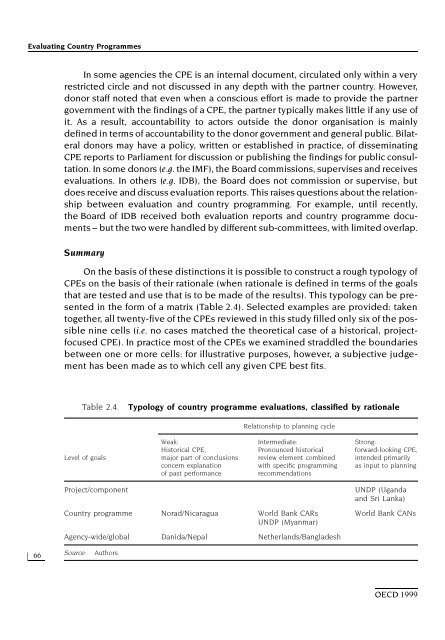Evaluating Country Programmes - OECD Online Bookshop
Evaluating Country Programmes - OECD Online Bookshop
Evaluating Country Programmes - OECD Online Bookshop
You also want an ePaper? Increase the reach of your titles
YUMPU automatically turns print PDFs into web optimized ePapers that Google loves.
<strong>Evaluating</strong> <strong>Country</strong> <strong>Programmes</strong><br />
66<br />
In some agencies the CPE is an internal document, circulated only within a very<br />
restricted circle and not discussed in any depth with the partner country. However,<br />
donor staff noted that even when a conscious effort is made to provide the partner<br />
government with the findings of a CPE, the partner typically makes little if any use of<br />
it. As a result, accountability to actors outside the donor organisation is mainly<br />
defined in terms of accountability to the donor government and general public. Bilateral<br />
donors may have a policy, written or established in practice, of disseminating<br />
CPE reports to Parliament for discussion or publishing the findings for public consultation.<br />
In some donors (e.g. the IMF), the Board commissions, supervises and receives<br />
evaluations. In others (e.g. IDB), the Board does not commission or supervise, but<br />
does receive and discuss evaluation reports. This raises questions about the relationship<br />
between evaluation and country programming. For example, until recently,<br />
the Board of IDB received both evaluation reports and country programme documents<br />
– but the two were handled by different sub-committees, with limited overlap.<br />
Summary<br />
On the basis of these distinctions it is possible to construct a rough typology of<br />
CPEs on the basis of their rationale (when rationale is defined in terms of the goals<br />
that are tested and use that is to be made of the results). This typology can be presented<br />
in the form of a matrix (Table 2.4). Selected examples are provided: taken<br />
together, all twenty-five of the CPEs reviewed in this study filled only six of the possible<br />
nine cells (i.e. no cases matched the theoretical case of a historical, projectfocused<br />
CPE). In practice most of the CPEs we examined straddled the boundaries<br />
between one or more cells: for illustrative purposes, however, a subjective judgement<br />
has been made as to which cell any given CPE best fits.<br />
Table 2.4. Typology of country programme evaluations, classified by rationale<br />
Relationship to planning cycle<br />
Weak: Intermediate: Strong:<br />
Historical CPE, Pronounced historical forward-looking CPE,<br />
Level of goals major part of conclusions review element combined intended primarily<br />
concern explanation with specific programming as input to planning<br />
of past performance recommendations<br />
Project/component UNDP (Uganda<br />
and Sri Lanka)<br />
<strong>Country</strong> programme Norad/Nicaragua World Bank CARs<br />
UNDP (Myanmar)<br />
World Bank CANs<br />
Agency-wide/global Danida/Nepal Netherlands/Bangladesh<br />
Source: Authors.<br />
<strong>OECD</strong> 1999

















![CQE=U]^\]Z: KAZAKHSTAN - OECD Online Bookshop](https://img.yumpu.com/3915768/1/190x253/cqeuz-kazakhstan-oecd-online-bookshop.jpg?quality=85)